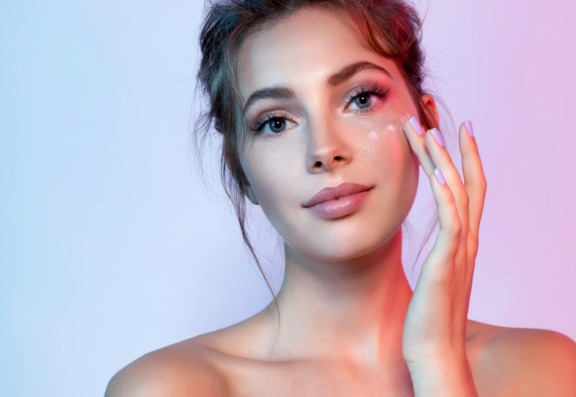Your skin is unique to you. Skin type and skin condition differ from person to person – it can be anything from oily, acne-prone to dry and sensitive skin.
When you discover your skin type and condition always use the best products suitable for your skin.
Many people aspire to look younger and want their skin to be acne and wrinkle-free with no pigmentation or blemishes.
I believe this is true it’s what I want and what I want for my clients too!
Good products prescribed from a good consultation can soothe your skin and give you that long-lasting glow.
Do you want healthy-looking and glowing skin?
Let me fill you in on the broad skin care parameters and the best products for your type of skin problem or concern...

Acne - what is it and what can you do?
Acne is a chronic, multi-factored condition that begins in the hair follicle of the sebaceous glands.
The main factor for developing acne is increased secretion of sebum of the sebaceous glands which can ultimately lead to the appearance of ‘blackheads’ causing the sebaceous glands to be stretched even more.
Acne sometimes leads to bacterial infections which need to be treated.
Discoloration / Pigmentation / hyperpigmentation
Discoloured skin patches are irregular areas where there are changes in skin colour. They are a common problem with a wide array of potential causes. Some of the more common causes of changes in skin colour are illness, injury, and inflammatory problems.
Discoloured skin patches also commonly develop in a certain part of the body due to a difference in melanin levels. Melanin is the substance that provides colour to the skin and protects it from the sun.
When there is an overproduction of melanin in a given area, it can result in skin discolouration in that area.
Redness and Irritation
Skin redness and sensitivity are defined as an inflammation of the epidermal layer of the skin.
The cause can be allergies, infection, or a hereditary tendency such as seborrheic dermatitis, rosacea, or atopic dermatitis. The term atopic means non-typical and therefore refers to a hereditary tendency.

“Natural” / chronological (age-related) ageing causes the skin to be thinner, vulnerable, dry, less flexible and harder. This type of ageing skin is the result of exposure to the sun’s rays (UV).
UV rays cause thickening of the skin making it rough and giving it an uneven appearance (distribution of the pigmentation cells), so you are left with an uneven complexion.
The damage from the sun’s rays is expressed also in the deeper skin layers. In the dermis layer, the sun destroys the collagen fibres and the elastin fibres and turns them into granular, useless material. The skin loses its strength and flexibility, and subsequently, deep wrinkles are formed, leaving the skin to sag.
The small blood vessels in the skin are also damaged and become fragile, and therefore contusions occur with every touch, pressure, or cut.
The Skin Types and Product Recommendations
Normal skin has a uniform hue and texture, without blemishes or visible pores. The skin has a tendency to burn after long exposure to the sun. Pimples appear usually in the T area (forehead, nose, chin). The skin’s complexion is usually light. After the face is cleaned, there is a feeling of skin that is tight and dry.
Oily skin has hyper-functioning sebaceous glands, wide-open pores, the tendency for ‘blackheads’ and a thick texture – while it is occasionally coarse and rough.
Oily skin is slow to wrinkle and tans relatively easily with a complexion that ranges from olive to dark. After the face is cleaned, oily skin has a tendency to shine approximately for one hour after.
Dry skin has hypo-functioning sebaceous glands and a greater tendency for injuries from external factors, including sun and wind). As the skin gets older, dry skin tends to separate between the skin’s layers, pores close, and the skin tends to wrinkle.
Dry skin has a light complexion, burns easily in the sun and peels immediately thereafter. After the face is cleaned, there is a feeling of tension, often accompanied by a feeling of having been bitten and itching, with an emphasis placed on the winter and seasonal changes.
If you want to read more, the experts at Consulting Room really know what they're talking about and have put together some Acne, Pigmentation, Rosacea, Sun Protection, complexion improvement, and Lines and wrinkles FAQs just for you.
If you have more questions, you can use the Acne, Pigmentation, Rosacea, Sun Protection, complexion improvement, and Lines and wrinkles questions feature to talk to our panel of trained medical experts.
If you're keen to get started with any of these treatments right away then you're in luck - those clever folks also have a list of trusted, accredited Acne, Pigmentation, Rosacea, Sun Protection, complexion improvement, and Lines and wrinkles clinics in your area.
Here we’ll guide you through how to identify its triggers and what you can do to prevent it.
Did you know that happy guts = happy skin?
Did you know your gut health can affect your skin? Our latest blog dives into the fascinating connection between digestion and skin wellness — exploring how a healthy gut can support clearer, more radiant skin.
Hey, wait!
Before you go.....
Let's stay in touch, pop your details here and we'll send our editor's hand-picked updates on your fave subjects.